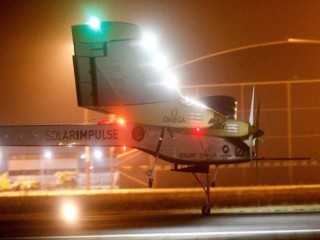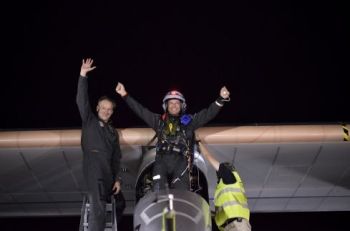
First solar energy plane Solar Impulse safely landed in Morocco after 19-hour flight
As the Solar Impulse project began in 2003 with a 10-year budget of 90 million euros ($112.18 million), it has involved engineers from Schindler, the Swiss elevator manufacturer, as well as research aid from Belgian chemical group Solvay.The Solar Impulse plane that took off from Madrid finished its 19-hour intercontinental flight on Tuesday. The solar energy plane landed in Rabat's airport, Morocco completing the world's first intercontinental flight powered by the sun to show the potential for pollution-free air travel.
Shortly before Swiss pilot Bertrand Piccard landed at Rabat airport, the project co-founder and pilot Andre Borschberg said the aircraft has proved its sustainability. "The aircraft can now fly day and night. It's quite a show ... It's a technology we can trust," he told reporters.
Pilot Piccard descended from the plane, smiling as he was greeted by Borshberg and Mustafa Bakkoury, the head of Morocco's solar energy agency. The aircraft's Tuesday flight which crossed the Gibraltar Strait separating Africa and Europe at one of its narrowest points, is crucial for the project's developers, because it would help improve the organization of a world tour planned in 2013.
As the Solar Impulse project began in 2003 with a 10-year budget of 90 million euros ($112.18 million), it has involved engineers from Schindler, the Swiss elevator manufacturer, as well as research aid from Belgian chemical group Solvay.
The plane, which requires 12,000 solar cells, embarked on its first flight in April 2010 and completed a 26-hour flight, a record flying time for a solar-powered aircraft, three months later. It made its first international flight last month when it completed a 13-hour trip from the western Swiss town of Payern to Brussels.
Still, with an average flying speed of 44 mph (70 kilometers per hour), Solar Impulse is not an immediate threat to commercial jets, which can easily cruise at more than 10 times the speed. The typical commercial jet can make the flight from Madrid to Rabat in a little more than an hour.

 Fierce and Fearless: Greta Gerwig's 'Barbie' Claims Title of Highest-Grossing Female-Directed Film
Fierce and Fearless: Greta Gerwig's 'Barbie' Claims Title of Highest-Grossing Female-Directed Filmadded on Monday 24th July 2023













